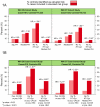Identifying post-menopausal women at elevated risk for epithelial ovarian cancer
- PMID: 26343159
- PMCID: PMC4664187
- DOI: 10.1016/j.ygyno.2015.08.024
Identifying post-menopausal women at elevated risk for epithelial ovarian cancer
Abstract
Objective: We developed and validated a hybrid risk classifier combining serum markers and epidemiologic risk factors to identify post-menopausal women at elevated risk for invasive fallopian tube, primary peritoneal, and ovarian epithelial carcinoma.
Methods: To select epidemiologic risk factors for use in the classifier, Cox proportional hazards analyses were conducted using 74,786 Women's Health Initiative (WHI) Observational Study (OS) participants. To construct a combination classifier, 210 WHI OS cases and 536 matched controls with serum marker measurements were analyzed; validation employed 143 cases and 725 matched controls from the WHI Clinical Trial (CT) with similar data.
Results: Analyses identified a combination risk classifier composed of two elevated-risk groups: 1) women with CA125 or HE4 exceeding a 98% specificity threshold; and 2) women with intact fallopian tubes, prior use of menopausal hormone therapy for at least two years, and either a first degree relative with breast or ovarian cancer or a personal history of breast cancer. In the WHI OS population, it classified 13% of women as elevated risk, identifying 30% of ovarian cancers diagnosed up to 7.8years post-enrollment (Hazard Ratio [HR]=2.6, p<0.001). In the WHI CT validation population, it classified 8% of women as elevated risk, identifying 31% of cancers diagnosed within 7years of enrollment (HR=4.6, p<0.001).
Conclusion: CA125 and HE4 contributed significantly to a risk prediction classifier combining serum markers with epidemiologic risk factors. The hybrid risk classifier may be useful to identify post-menopausal women who would benefit from timely surgical intervention to prevent epithelial ovarian cancer.
Keywords: CA125; HE4; Ovarian cancer; Risk prediction.
Copyright © 2015 Elsevier Inc. All rights reserved.
Figures
References
-
- Nelson HD, Fu R, Goddard K, Mitchell JP, Okinaka-Hu L, Pappas M, et al. Risk Assessment, Genetic Counseling, and Genetic Testing for BRCA-Related Cancer: Systematic Review to Update the US Preventive Services Task Force Recommendation. Rockville (MD): 2013. - PubMed
Publication types
MeSH terms
Substances
Grants and funding
- HHSN268201100001I/HL/NHLBI NIH HHS/United States
- HHSN268201100046C/HL/NHLBI NIH HHS/United States
- HHSN268201100003C/WH/WHI NIH HHS/United States
- P50 CA083636/CA/NCI NIH HHS/United States
- HHSN271201100004C/AG/NIA NIH HHS/United States
- HHSN268201100002C/WH/WHI NIH HHS/United States
- HHSN268201100001C/WH/WHI NIH HHS/United States
- HHSN268201100004C/WH/WHI NIH HHS/United States
- P30 CA015704/CA/NCI NIH HHS/United States
- HHSN268201100004I/HL/NHLBI NIH HHS/United States
- U01 CA152637/CA/NCI NIH HHS/United States
- HHSN268201100003I/HL/NHLBI NIH HHS/United States
- HHSN268201100002I/HL/NHLBI NIH HHS/United States
- R21 CA179443/CA/NCI NIH HHS/United States
LinkOut - more resources
Full Text Sources
Other Literature Sources
Medical
Research Materials
Miscellaneous


